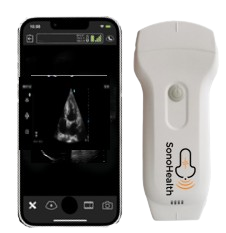In today’s fast-evolving healthcare landscape, precision, efficiency, and accessibility are more critical than ever. One tool that has revolutionized diagnostic capabilities across various medical fields is the portable ultrasound machine. Once restricted to large hospitals or specialized radiology departments, ultrasound technology has now become accessible to physicians in clinics, emergency rooms, and even in rural or underserved areas, thanks to the advancement of portable models. Here’s why every physician should consider integrating a portable ultrasound machine into their practice, and what to keep in mind when making a purchase.
Handheld Wireless Color Doppler Ultrasound
Experience Precision at Your Fingertips!
Discover the power of Handheld Wireless Color Doppler Ultrasound—portable, accurate, and designed for real-time diagnostics anywhere.
Why Portable Ultrasound Machines are Essential for Physicians
- Point-of-Care Diagnostics
- Portable ultrasound machines allow for real-time, point-of-care diagnostics. Whether in a busy emergency department, a remote rural clinic, or during a home visit, physicians can make quick and informed decisions. Ultrasounds provide crucial information in situations involving trauma, cardiac conditions, musculoskeletal injuries, and even obstetric care.
- Improved Patient Outcomes
Time is often a critical factor in determining a patient’s outcome. Having an ultrasound on hand can significantly reduce the time it takes to diagnose conditions such as internal bleeding, deep vein thrombosis, or organ abnormalities. With faster diagnosis comes quicker intervention, potentially saving lives or preventing complications. - Non-Invasive and Safe
Ultrasound technology is one of the safest imaging techniques available. It uses sound waves, not radiation, to create images, making it a non-invasive and risk-free method for repeated use. This safety profile is especially advantageous for pregnant women, children, and patients requiring regular imaging. - Cost-Effective Solution
Compared to other imaging modalities like MRI or CT scans, portable ultrasound machines offer a more affordable option for both physicians and patients. Many healthcare providers find that owning a portable unit can help reduce referrals to other facilities, keeping costs lower for patients and improving the efficiency of care. - Versatility Across Specialties
Portable ultrasound devices are not limited to one type of physician. They are invaluable in cardiology, obstetrics, orthopedics, internal medicine, and even general practice. Their ability to assess soft tissues, blood flow, and organs makes them useful in a wide array of medical scenarios, from checking fetal health to diagnosing gallstones or cardiac issues. - Portability and Ease of Use
Modern portable ultrasound machines are lightweight, often handheld, and wireless. This mobility allows physicians to use them in various settings without the need for heavy or immobile equipment. The latest devices also come with user-friendly interfaces, making them accessible for both seasoned sonographers and physicians who are new to ultrasound diagnostics.
Buying Guide: How to Choose the Right Portable Ultrasound Machine
When considering a portable ultrasound machine for your practice, it’s important to look beyond just price and focus on features that match your needs. Here’s a guide to help you make the right decision:
- Image Quality
The primary function of an ultrasound machine is to provide clear, accurate images for diagnosis. Look for a device with high image resolution and color Doppler capability. The ability to view detailed images of tissues, vessels, and organs is crucial for accurate diagnosis. - Portability and Battery Life
If mobility is key to your practice, such as during home visits or in emergency situations, make sure the machine is truly portable—lightweight and compact. Check the battery life to ensure it can last through several patient exams without needing frequent recharging. - Wireless Connectivity
Many newer models come with wireless connectivity features, allowing images to be transmitted to other devices like tablets or smartphones, or even shared with other specialists for remote consultations. This feature can improve workflow and collaboration, especially in multi-disciplinary teams. - Durability and Build Quality
Portability often means that the ultrasound device will be exposed to various environments, including potentially rough handling during transportation. Opt for machines that are built to withstand frequent use and have a durable outer casing. - Software and User Interface
Easy-to-use software is essential for efficient diagnostics. Look for a machine that has intuitive controls, customizable settings, and, if possible, AI-based enhancements that help optimize image quality and assist with diagnostic suggestions. Some machines also come with preset modes for different specialties, like cardiology or obstetrics, which can be very helpful. - Probe Options
Different types of probes (transducers) are used to scan different parts of the body. Consider machines that offer a variety of probes, such as linear, convex, or phased array, to suit your medical needs. Wireless probes are increasingly popular as they enhance ease of use and mobility. - Price and Warranty
Prices for portable ultrasound machines can vary widely depending on their features. Establish a budget but be open to investing in features that will serve your practice in the long term. Also, look for manufacturers or suppliers that offer extended warranties and reliable after-sales support, as this can make a big difference in the machine’s upkeep and longevity. - Training and Support
Lastly, ensure that the vendor provides adequate training for your staff. Even though ultrasound technology has become more user-friendly, proper training ensures that you can maximize the device’s potential. Support for software updates, maintenance, and repairs is also crucial to keep your device functioning optimally.
Conclusion
Incorporating a portable ultrasound machine into your medical practice is no longer just a convenience—it’s quickly becoming an essential tool for providing high-quality care. Whether you’re a general practitioner, a specialist, or a physician working in remote areas, the ability to perform on-the-spot diagnostics can greatly enhance patient care, reduce costs, and improve outcomes. By considering the factors mentioned in the buying guide, you can ensure that the machine you choose meets both your current needs and future requirements as healthcare continues to evolve.





